How to Create Connections with People in a Digital World
Businesses and consumers have learned how to improvise and innovate with technology during the pandemic, and eCommerce is booming. Understanding shifts in consumer shopping behavior can empower brands and businesses to attract and engage consumers and win brand loyalty.
How 2020 Changed the Consumer Mindset
According to a recent Global WebIndex study, people of all ages are focusing more on wellness and mental health after over a year of isolation and stress created by the pandemic, economic uncertainty and the social climate in the U.S.
Most Americans are planning safe ways to spend more time with family and friends, and many are finding ways to feel better by pampering pets, learning new skills, discovering hobbies and planning future trips. Consumers of all ages say they are more interested in reading, and most younger consumers are looking for ‘how to’ blogs and online tools to learn, discover products and realize financial goals.
Just about everybody wants verbal and physical assurances that it is safe to venture inside businesses again. According to a Think with Google report, most people want to take more control of their lives to thrive, rather than rely on others to survive. Following the events of 2020, most consumers expect business leaders to take action to address diversity and inclusivity, and more people are concerned about the environmental impact of the products and packaging they buy.
The Current eCommerce Landscape
According to a study by Ecommerce Research, gains in eCommerce before the pandemic were mainly caused by generational shifts in shopping behavior, advancements in smartphone technology, simplification of online marketplaces and shoppable social media content.
Between 2012 and 2019, eCommerce sales were rising 10% annually, and during 2020, there was a surge in eCommerce. Over 84% of consumers shopped online during the pandemic due to health concerns, convenience and supply disruptions, and eCommerce sales increased over 30% in 2020, representing 14% of all retail sales according to the U.S. Department of Commerce.
Researchers believe people will eventually strike a balance between their pre-2020 routines, and the new shopping habits they developed during the pandemic. A study by Shopify found most consumers intend to continue shopping online after the pandemic because they like the convenience and personalized products.
A growing number of consumers prefer to shop online for brands in the health, hygiene, home essentials, food, beverage and pet categories. The main drivers for consumers to choose to buy products online instead of a store are product availability, home delivery, cheaper prices and the convenience of shopping at anytime from anywhere according to Statista.
A study published by the National Institutes of Health emphasizes the importance of ongoing consumer research to understand shifts in consumer behavior because new technology, safety procedures, health regulations and lingering safety and financial concerns are likely to have a lasting impact on the way people shop, and the products and services they want to buy.[/vc_column_text][divider line_type=”No Line” custom_height=”20″]
Understanding the Way Consumers Shop Can Increase Conversions and Sales
Consumers typically follow a logical series of steps before, during and after an online purchase. Understanding how people behave during the consumer journey for a particular product or service can empower brands and businesses to attract new customers and engage and win the loyalty of existing customers.
- Discover: Learn about products and services to buy
- Consideration: Read reviews online and research online and in stores to decide what to buy
- Conversion: Decide when and where to buy a product, or to abandon the cart
- Purchase: Buy a product or service for the first time in a store or online
- Evaluate: Use a mobile device or computer to rate and review the product and experience
- Re-purchase: Decide to buy products again online or in stores, or to abandon a brand
- Brand Advocate: Inspire other consumers to discover, consider and buy products and services through word of mouth, social media posts and online reviews
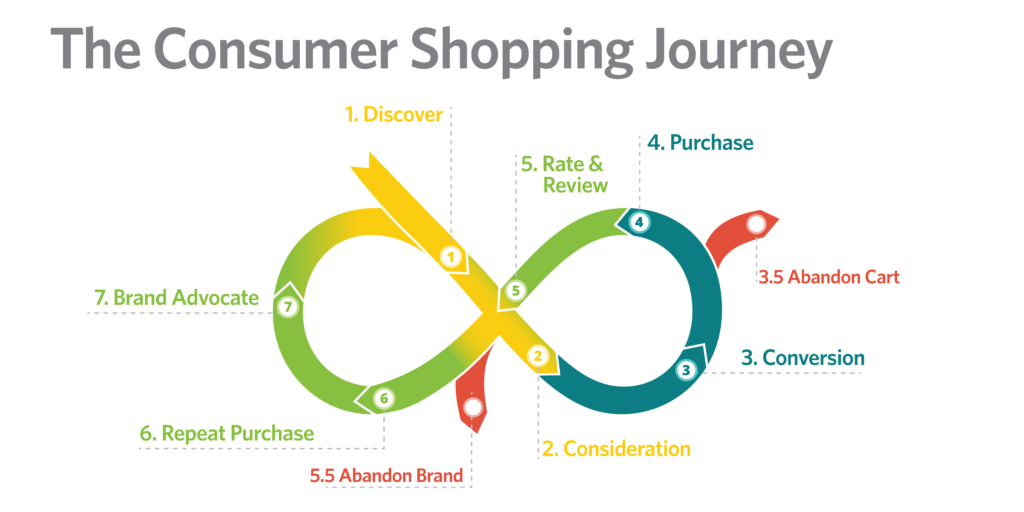
Sources: Ipsos, Global WebIndex, Statista
How Consumers Discover Products and Services to Buy
Online searches are now the main way people of all ages discover products and services they want to buy and most consumers use Google to search the internet according to Statista.
When a Google search term has an exponential increase, it’s a good indication there has been a significant shift in consumer demand. According to a recent Think with Google report, most people are currently searching for products or services to feel better and gain control of their current unpredictable environment.
People are searching for information about the emotional benefits of pets, nature, hobbies and camping, and more people are searching for topics with functional benefits like desks and chairs to work and go to school at home, as well as inspiration for cooking and home improvement projects.
In 2020 year-over-year Google searches grew exponentially for household essentials, hobbies, in-home entertainment, suburban real estate, education and home fitness:
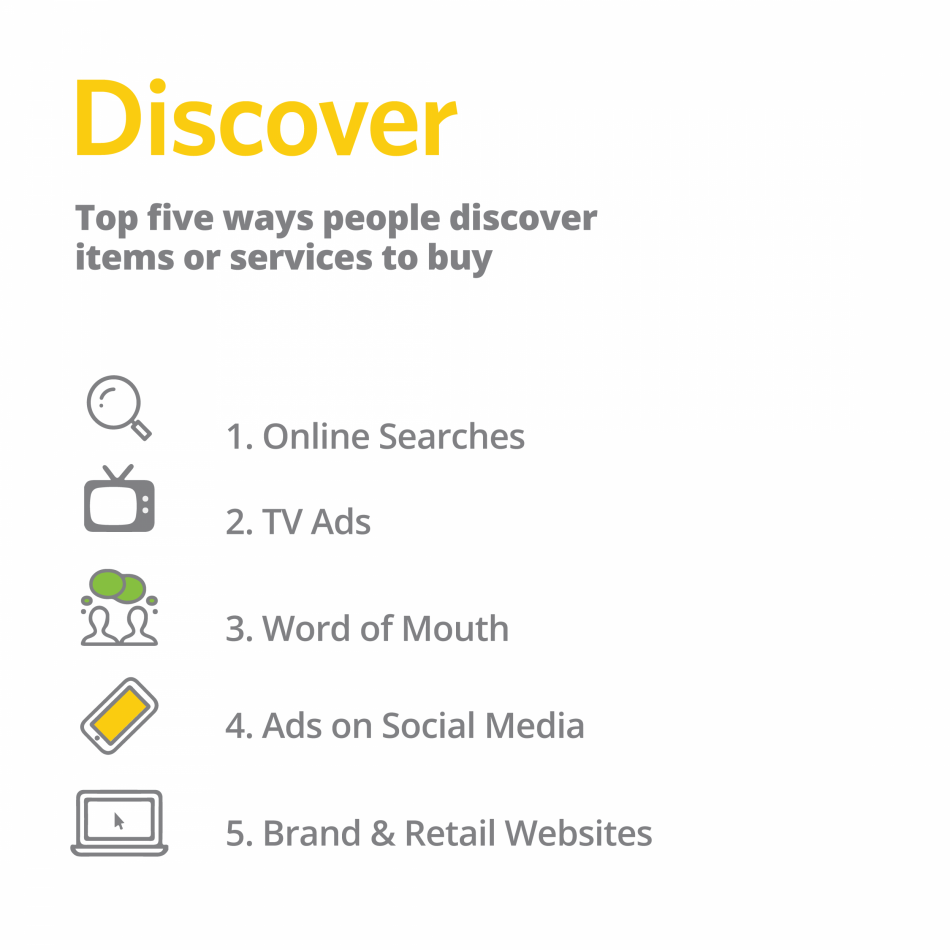
- Who has …. in stock: + 8,000%
- Things to do at home: + 600%
- Virtual home tour: + 500%
- Online learning + 400%
- Fitness apps + 200%
How Technology is Changing the Way People Decide What to Buy
Most consumers research businesses and products to decide what to buy, and online customer reviews and word of mouth are the most influential factors in the consideration process leading up to a purchase. The things consumers consider most often are price, product quality and availability.
Now that most consumers have made an online purchase, generational differences in the way people gather information are beginning to blur.
Before the pandemic, there was a distinct generational divide in the way people considered products or services. Most younger consumers use mobile devices to research products online and rely on YouTube videos and customer reviews to compare products or services. People over the age of 50 were more likely to rely on ads on TV, word of mouth recommendations from family and friends, ads and endorsements on social media networks – especially Facebook. Most older consumers preferred to call or visit businesses in person to see products before making a decision to buy.
Now, consumers over the age of 50 are the fastest growing segment of online shoppers and many have started watching YouTube reviews. However, most older consumers still prefer to use computers instead of mobile devices to shop, and many are motivated to make a purchase by traditional advertising, social media ads and email that they receive from brands or businesses that they trust.
Sources: Bright Local, Kantar, Kelton Global Retail-Me-Not Study, Ipsos, Think with Google
When deciding what to buy, most consumers trust online reviews by other customers and personal recommendations from friends and family. Most people read online reviews to choose:
- Restaurants
- Hotels
- Medical Care Providers
- Automotive Services
- Clothing Stores
What Motivates People to Make an Online Purchase
Most shoppers decide when and where to make a purchase based on total cost, convenience and how quickly they need to have an item or service.
Product availability and safety concerns about shopping in stores motivated over 90% of consumers to shop online in 2020, and time-consuming online checkout procedures, unexpected fees and privacy or security concerns deterred 70% of online purchases prior to 2020 according to a Global WebIndex report.
Sources: Chain Store Age, Interactive Advertising Bureau, Kantar, Statista
The top five products consumers now buy online are:
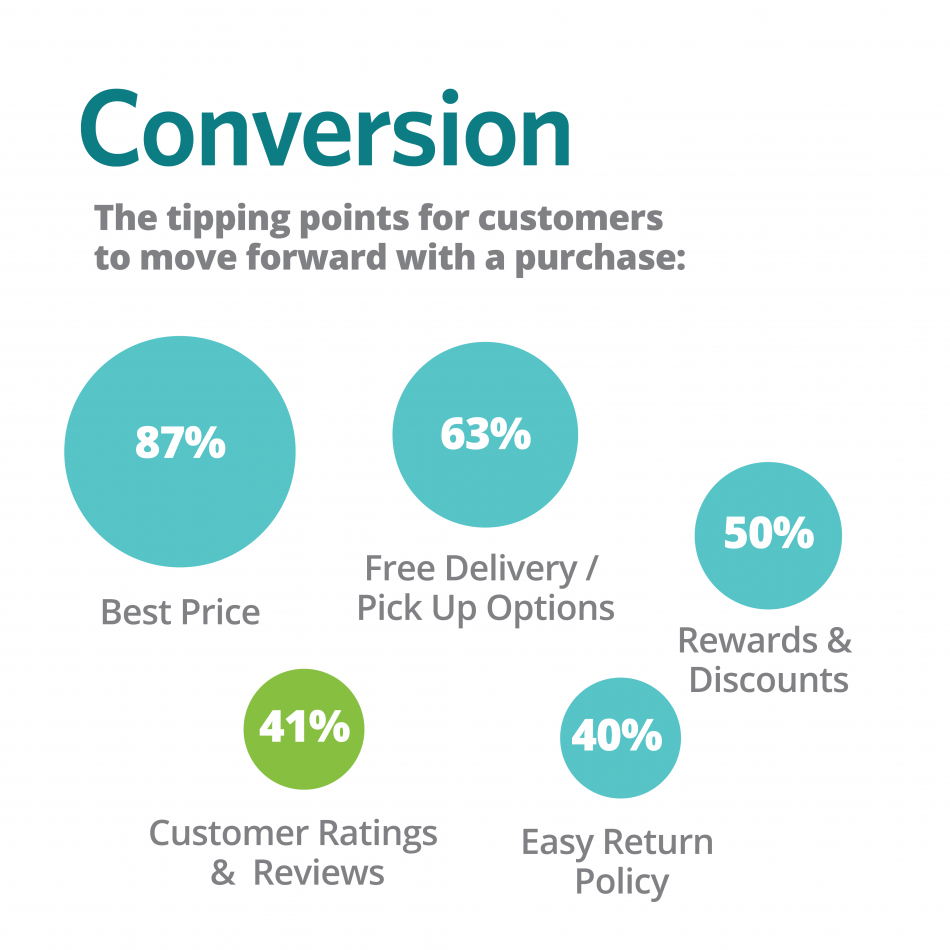
- Pet Food & Supplies
- Household Care Products
- Health & Beauty Products
- Food, Beverages & Grocery Store Items
- Baby Care Products
How Marketers Can Reach People Online at the Moment They Decide to Buy
Understanding how customers shop is the best way to learn how to seize the moment when people decide to buy. The consumer shopping journey is normally an omni-channel experience and social media now plays a major role before, during and after a purchase.
There are generational differences in the way people make online purchases, with most younger consumers using mobile devices, and most consumers over the age of 50 using computers. Three out of four online shoppers abandon carts because they switch from a mobile device to a computer due to a difficult checkout process, or decide it will be quicker, cheaper or more convenient to visit a physical store.
Sources: Baymard Institute, Global WebIndex, Ipsos, Shopify
Five touchpoints that boost online sales:
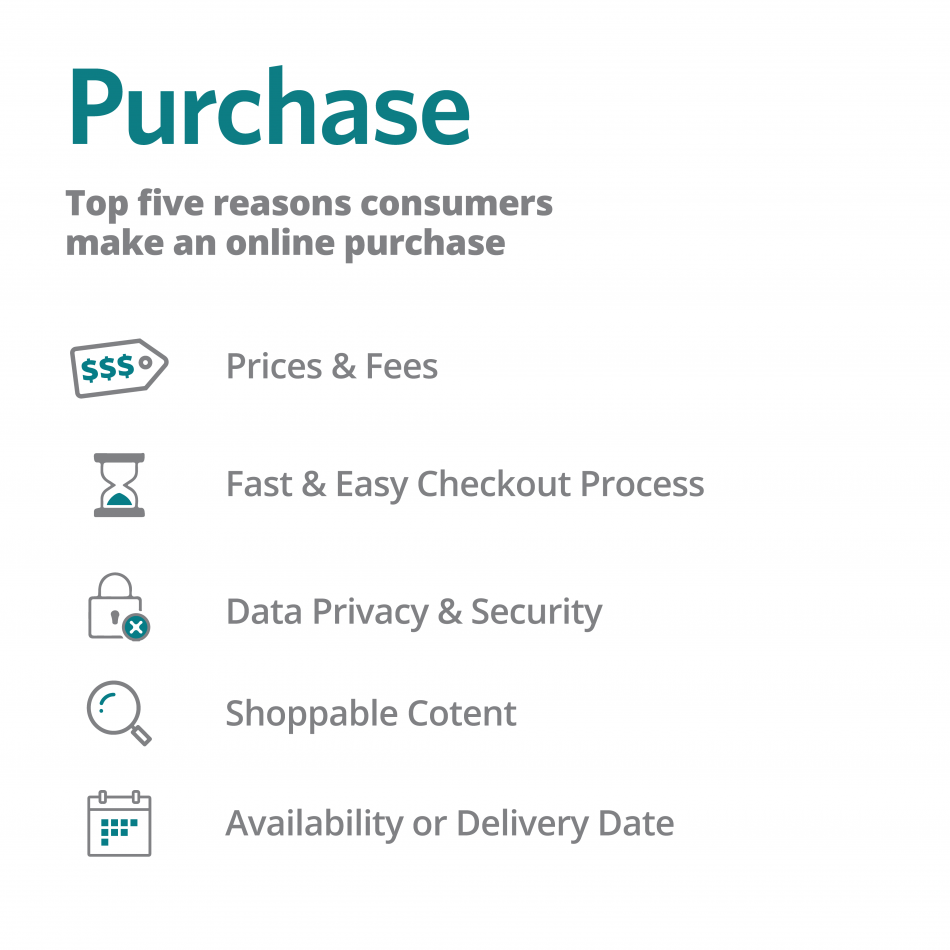
- Online & Social Media Ads with Shoppable Content
- Online Ratings and Reviews
- Responsive Brand & Retail Websites
- Online Purchases in Stores
- Customer Service Chats
Why It’s Important to Ask Customers To Rate Purchases And Their Experience
Brands and retailers reach new consumers and build customer loyalty by requesting and responding to customer ratings and reviews — and businesses gain actionable insights about their products, services, organizational capabilities and the customer shopping experience.
The internet and social media give customers a voice to spread the word about products and experiences they love — or don’t, and 84% of consumers trust other customers’ recommendations when they decide what to buy according to a recent study published by Northwestern University.
After making a purchase, 71% of consumers will rate and review their experience if brands and businesses send an email with a simple evaluation form. However, only one in five people take the time to submit a review after a negative shopping experience.
Sources: Ipsos, BrightLocal Consumer Review Survey, Spiegel Research Center-Northwestern University
Five essentials for high consumer ratings:
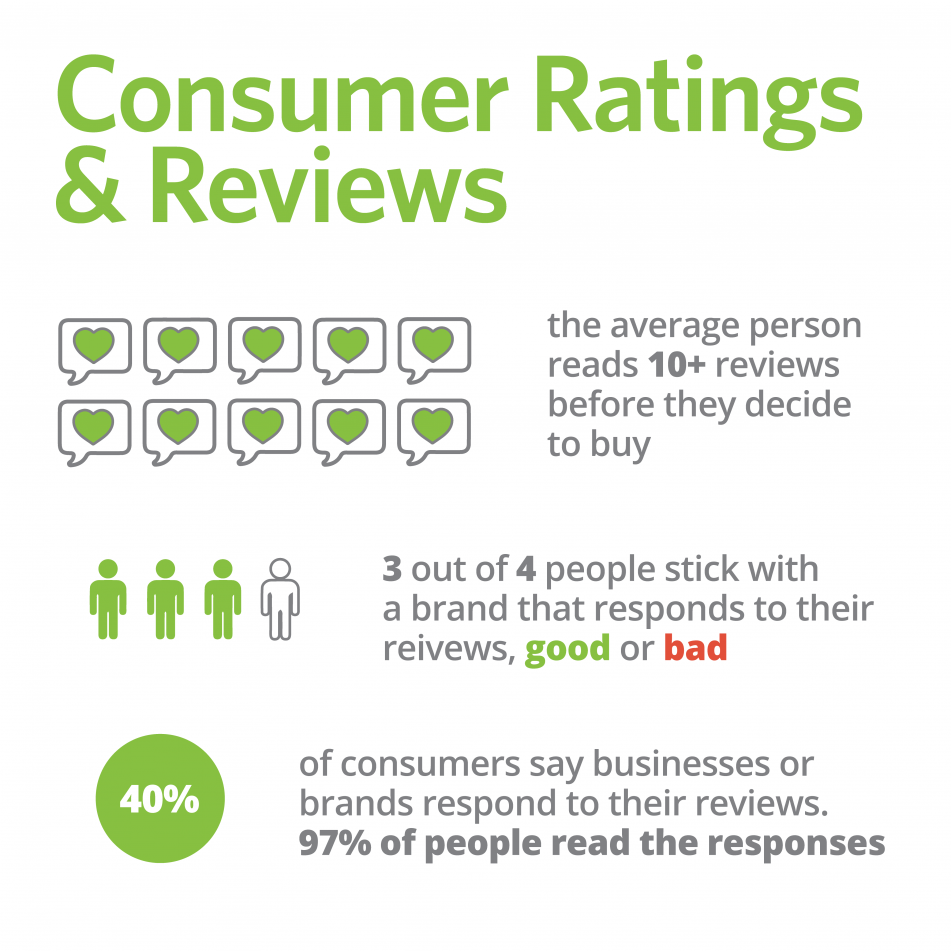
- Good Price
- Quick Response to Problems
- On Time Delivery
- Order Fulfillment
- Positive Experience / Interaction
What Motivates Consumers to Make a Repeat Purchase Online?
Product quality, shopping experience, availability and discounts impact purchase frequency, and often motivate consumers to repeat a purchase online. According to a Google-Ipsos study, special promotions motivate 77% of consumers to repurchase a product or service, and personalized offers appeal to 63% of shoppers.
Repeat online purchases usually occur with established customers who frequently purchase a product or service, and most consumers are motivated by product quality, discounts, convenience and interaction with the brand or business through engaging emails, social media posts or loyalty programs.
Sources: Ipsos, GlobalWebIndex, Shopify
Five products consumers often purchase again online after an initial in-store purchase:
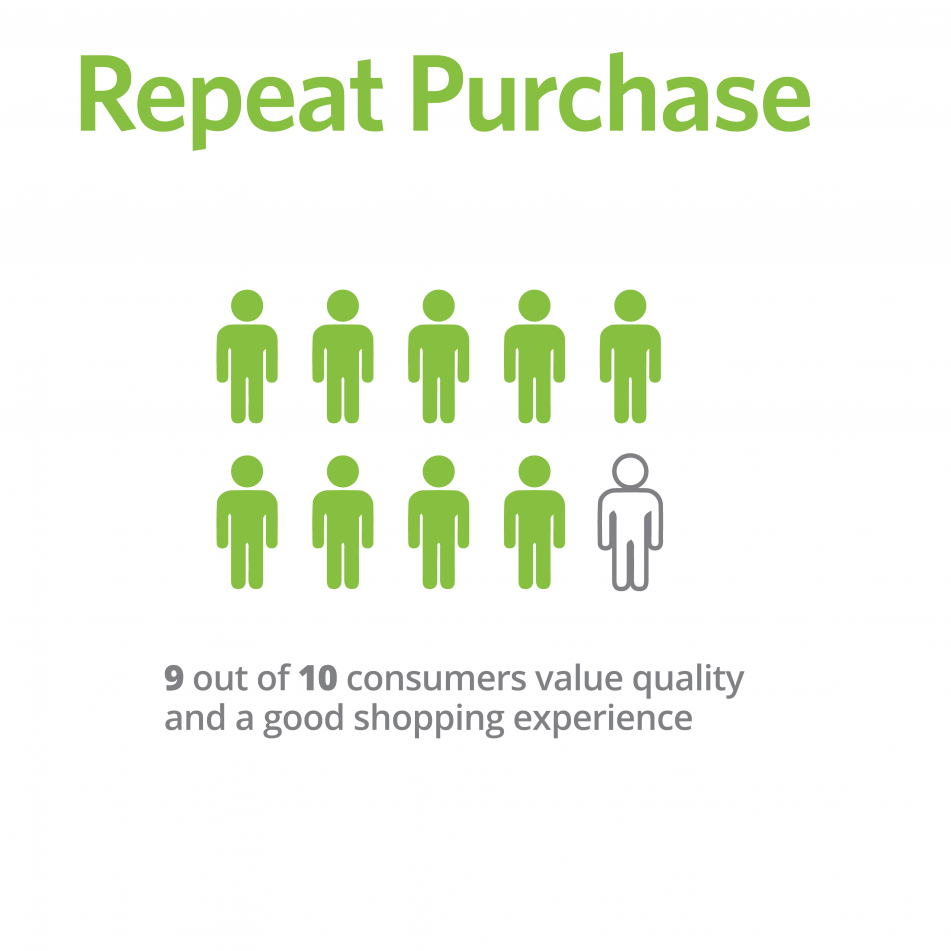
- Office Supplies
- Electronics
- Luxury Fashion
- Pet Supplies
- Vitamins & Nutrition Supplements
What Inspires People to Feel Brand Loyalty?
People usually feel loyalty toward the brands that are part of their routines, lifestyle and personal image. Increasingly, consumers expect brands and businesses to advocate for social issues and community needs. In fact, the 2021 Edelman Trust Barometer found 86% of consumers expect CEOs to publicly speak out and provide leadership for businesses to address local community needs and societal challenges.
However, supply disruptions during the pandemic have shaken up brand loyalty, and opened a window of opportunity for microbrands and private labels from retailers. According to a McKinsey report, 75% of consumers have tried different stores, websites or brands during the pandemic, and 60% of these consumers expect to integrate the new brands and shopping habits into their post-pandemic routines.
Inspiring brand loyalty is increasingly important for growth strategies because one out of every four consumers discover a brand or business through a social media post by a loyal customer according to Ipsos. The internet and social media give loyal customers a voice to spread the word about products or experiences they love, and high-quality products are likely to turn 48% of consumers into brand advocates on social media.
Sources: Edelman Trust Barometer, McKinsey, Fortune
Five essentials for brand loyalty:

- Great Customer Service
- Personalized Shopping Experiences
- Feeling Connected to a Business or Brand through Communication
- Loyalty Rewards & Discounts
- Asking for and Responding to Customer Feedback
How To Gain Actionable Consumer Insights
Quick-Turn consumer research enables marketers take the pulse of consumers in real time to gain data and marketing insights to support immediate decisions. More in-depth qualitative and quantitative market research presents actionable consumer insights to support growth and innovation strategies, and helps to optimize the rate of return on marketing investments:
- Benchmarking and Competitor Analysis provides current and historic data to optimize strategies, products, packaging and marketing communications plans.
- Consumer Attitude and Usage Studies (A&U) explain how, when and where people use products, and define the perceptions and attitudes that motivate consumers to buy (or not buy) a product.
- Packaging Research uses a variety of different consumer surveys and statistical techniques to optimize package design, structure and shelf placement to appeal to more consumers.
- Segmentation & Message Testing provide actionable consumer insights to create meaningful connections between brands and the right target audiences.
Follow our consumer insights blog series to learn how lifestyle changes, demographic shifts and buying behavior are expected to drive growth and innovation, and learn more here:
- How will Pent Up Demand & Vaccines Affect Buying Behavior?
- Understanding the Consumer Journey Optimizes Customer Experiences
- Five Ways Brands Win Consumer Sentiment
- Is Social Media the New Storefront?
- Food & Beverage Insights: 5 Consumer Behaviors Inspiring Brand Innovation
Insights In Marketing is a marketing research firm that delivers in-depth and actionable insights so you can have every confidence your decisions are inspired by the consumer voice. Our Team has decades of client and supplier side research experience, and our marketing expertise spans across various industries and consumer segments.
Looking to Create a Genuine Connection with Your Customers?
Share this article:
Related Resources
Sip, Sip, Hooray!
Sip, Sip, Hooray! The RTD Cocktail Craze and the Mocktail MovementThere’s something special about a perfectly…
From Idea to Icon: The Life Cycle of a Super Bowl Ad
From Idea to Icon: The Life Cycle of a Super Bowl AdA…
Seizing Business Opportunities in the GLP Era
While GLP medications disrupt traditional health and wellness models, they also present unique opportunities for…
The Generational Shifts in Health and Wellness: What It Means for Businesses
As consumers increasingly prioritize health and wellness, generational preferences and behaviors are driving a…




